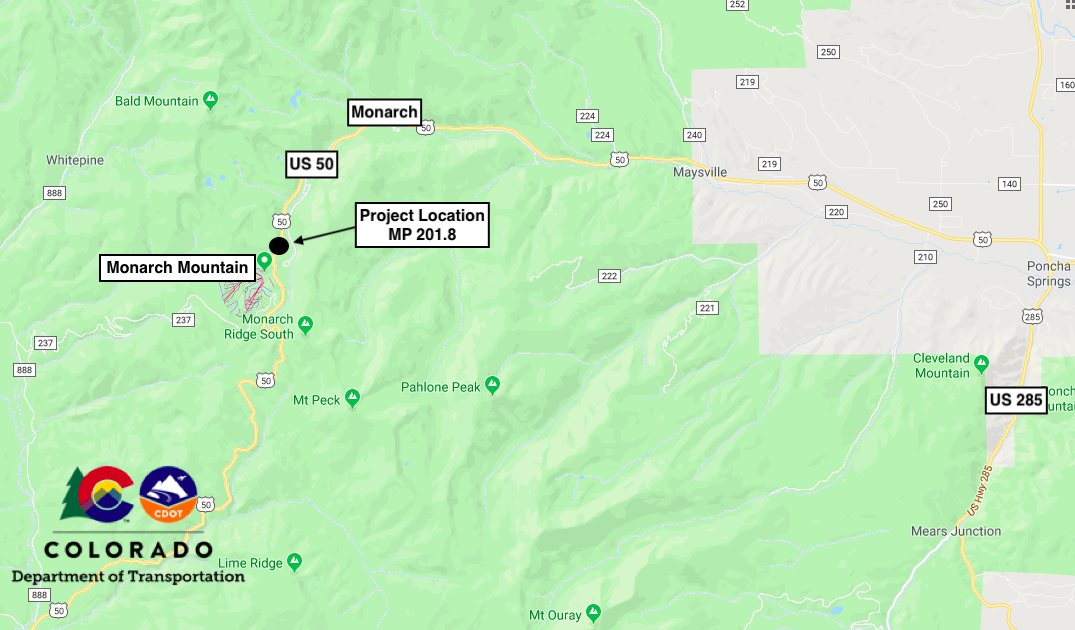CDOT to install remote avalanche control system on US 50 Monarch Pass
CHAFFEE COUNTY—On Aug. 5, CDOT will begin installing new avalanche-control equipment above US Highway 50 Monarch Pass, about 15 miles west of Poncha Springs. Construction efforts will consist of installing a control shelter and a remote avalanche control system at a known snow slide path location on the pass.
Work will take place above US 50 between mile points 201.0 and 202.0, near the Monarch Ski Area.
Midwest Rockfall, Inc. of Henderson, Colorado, is the prime contractor on this $366,000 project.
 Project Location Map
Project Location Map
TRAVEL IMPACTS
-
Regular work hours are Monday through Friday from 7 a.m. to 5 p.m. No weekend work is anticipated.
-
Motorists should expect minimal traffic impacts since most work will take place off of the highway.
-
The public will be notified of periodic full eastbound and westbound lane closures to facilitate rock scaling and helicopter operations. These closures will occur for no more than 20-minute intervals, a total of 10 times throughout the duration of the entire project. Otherwise, US 50 will remain open as normal.
-
Work is expected to end in October 2019, weather dependent.
PROJECT BACKGROUND
As part of CDOT's Whole System — Whole Safety initiative this new avalanche control system will ensure a safer avalanche mitigation program for CDOT and the public. The US 50 avalanche control project includes installing a control shelter which will house equipment needed for the operation of the remote avalanche control system near the Monarch Ski Area. The new system will provide more efficient avalanche control, making the area safer for the traveling public. This remote system is also more reliable and safer for CDOT personnel to operate. CDOT currently operates more than 30 remote systems at several locations on high mountain highways and the I-70 mountain corridor.
Every winter CDOT and sister agency, the Colorado Avalanche Information Center, regularly monitor and control some 278 of 522 known avalanche paths located above Colorado highways. The monitoring and mitigation help prevent natural avalanches from impacting public travel. When there is high risk of avalanche danger, CDOT will close highways at the location of the avalanche path in order to conduct avalanche control operations. While the road is safely closed to any traffic, avalanches are triggered. Maintenance crews with heavy equipment then clear the highway of any snow and debris that reached the road. The highway can then be re-opened for safer public travel.
PROJECT INFORMATION
Get direct email announcements and updates by signing up at [email protected]. For additional information about this project, call the local project information line at 970.373.1584, or visit the project website at codot.gov/projects/monarch-pass-avalanche-control-shelter. Information about weekly lane closures is available at codot.gov/travel/scheduled-lane-closures.html. For information regarding CDOT projects statewide, log on to codot.gov. Updates are also available via Twitter @coloradodot and on Facebook, facebook.com/coloradodot.
WHOLE SYSTEM. WHOLE SAFETY.
To heighten safety awareness, CDOT announced its Whole System — Whole Safety initiative earlier this year. This project takes a systematic statewide approach to safety combining the benefits of CDOT's programs that address driving behaviors, our built environment and the organization's operations. The goal is to improve the safety of Colorado's transportation network by reducing the rate and severity of crashes and improving the safety of all transportation modes. The program has one simple mission—to get everyone home safely.
ABOUT CDOT
CDOT has approximately 3,000 employees throughout Colorado, and manages more than 23,000 lane miles of highway and 3,429 bridges. CDOT also manages grant partnerships with a range of other agencies, including metropolitan planning organizations, local governments and airports. It also administers Bustang, the state-owned and operated interregional express service. Gov. Jared Polis has charged CDOT to further build on the state's inter-modal mobility options.
